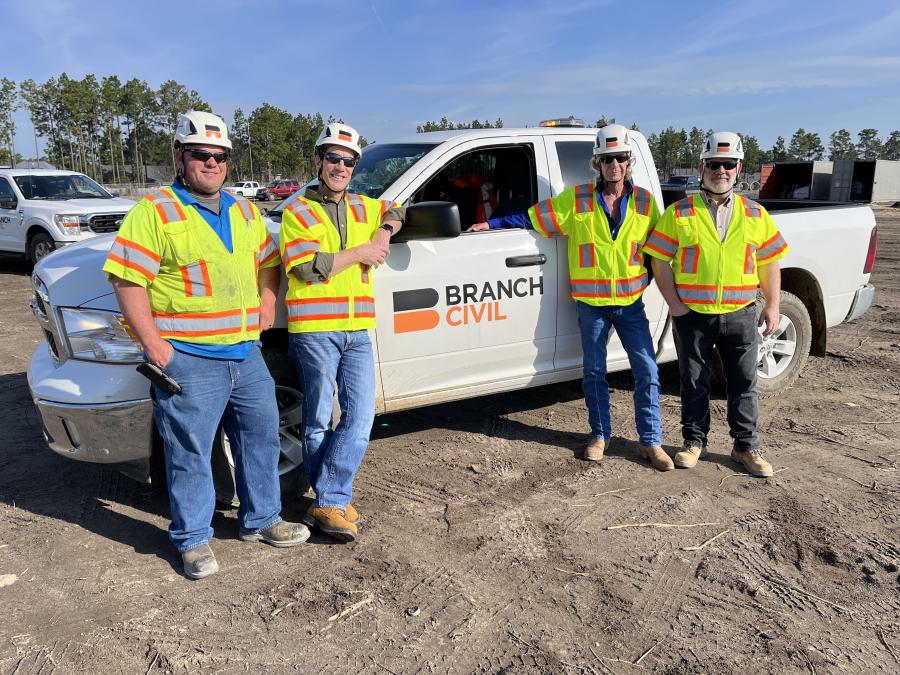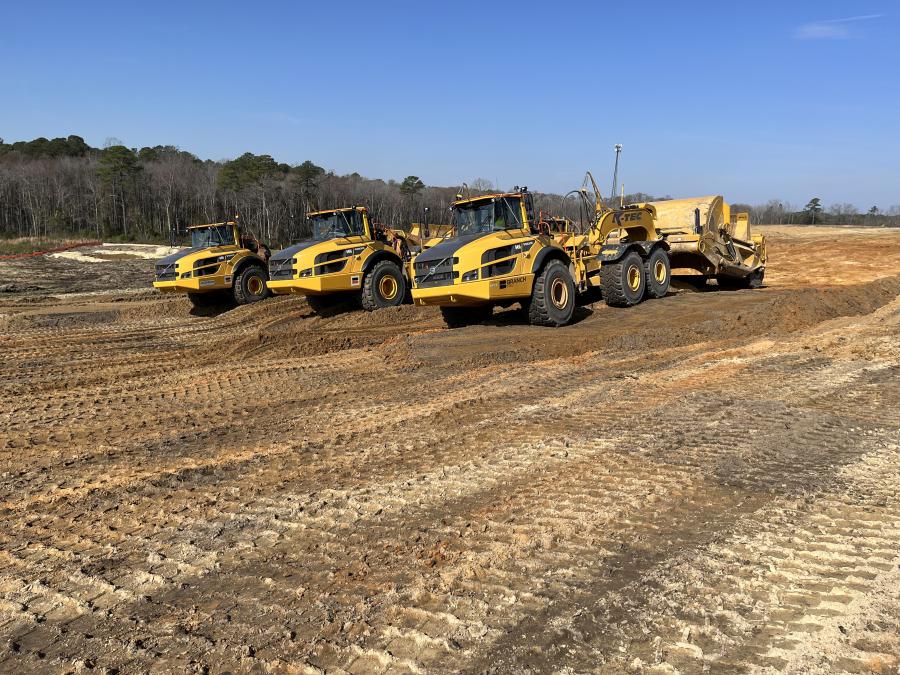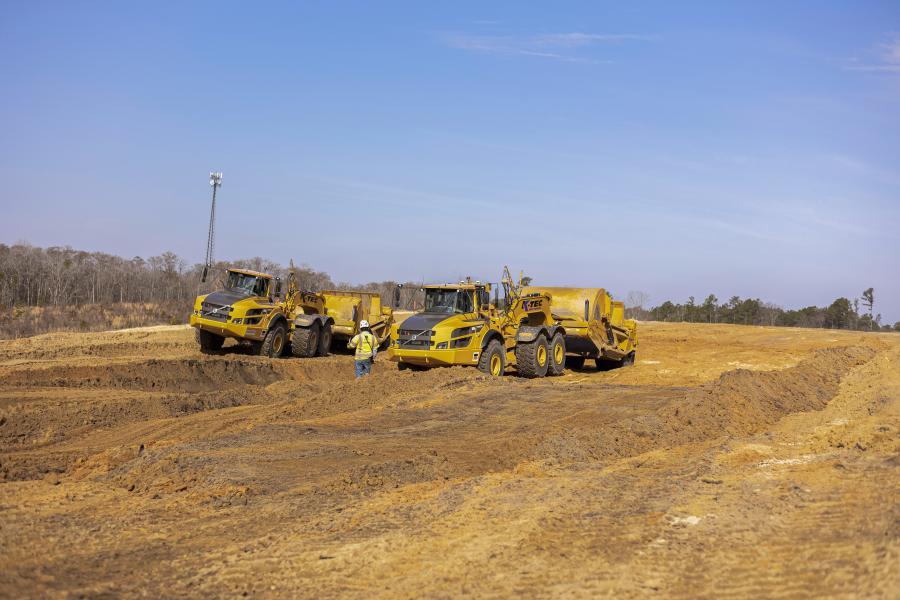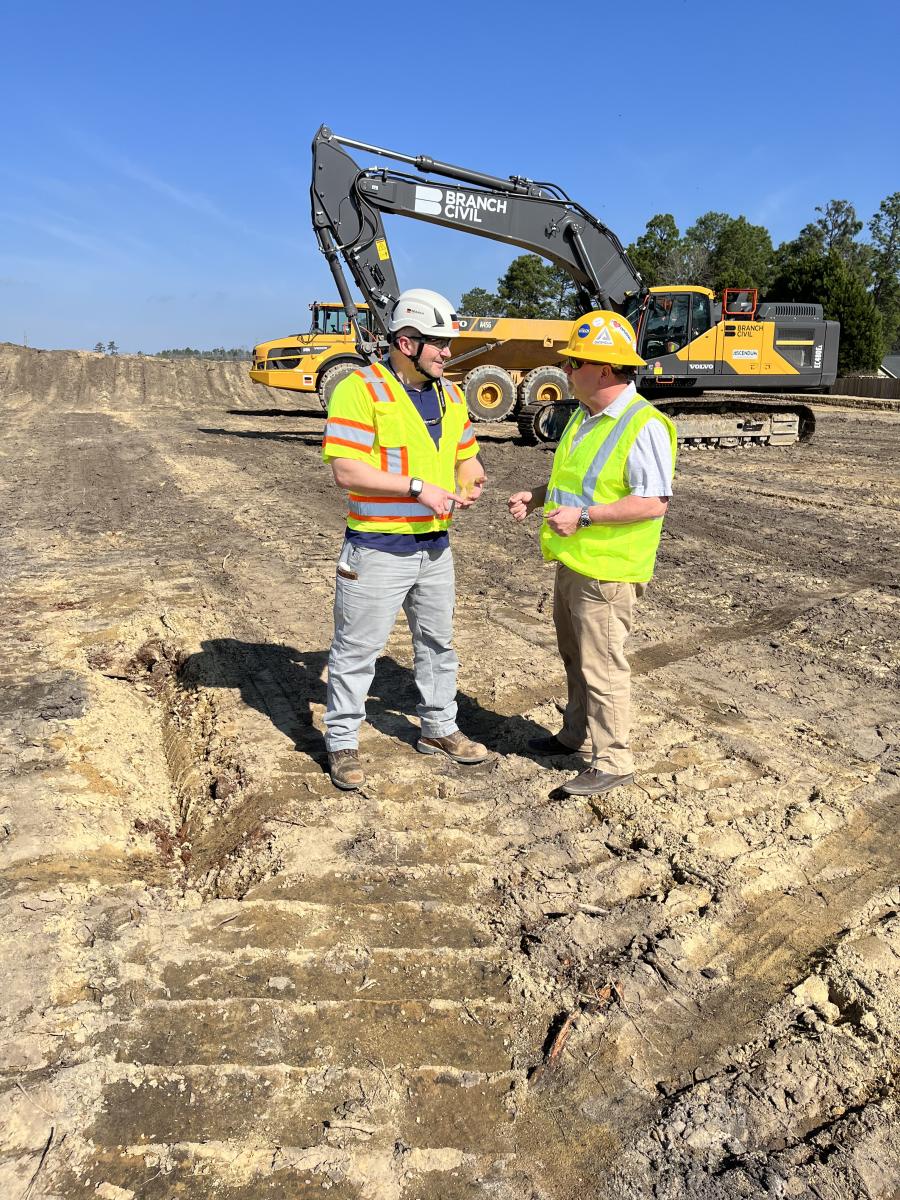(L-R) are Terry Whitson, Brian Quinlan, president; Donald Jeffery; and Chris Bain, all of Branch Civil.
(CEG photo)
A contract for the final leg of North Carolina's long-awaited Interstate 295/Fayetteville Outer Loop project was awarded this past summer to Branch Civil, a subsidiary of Branch Group, and one of the East Coast's most prestigious heavy construction firms.
Valued at $152 million, the contract calls for Branch to build a 5-mi.-long stretch of new four-lane divided highway in Cumberland County between Camden Road, near Hope Mills, and U.S. Highway 401/Raeford Road, in west Fayetteville.
The project also includes installing four overpasses, two mainline bridges and two interchanges. One interchange for the future I-295 will be created at Camden Road, southwest of Jack Britt High School, and the second will be built on a realigned Strickland Bridge Road, south of Century Circle.
In addition, crews will install 43,000 linear ft. of drainage pipes and $30 million worth of asphalt pavement.
A date of May 15, 2026, has been set by the North Carolina Department of Transportation (NCDOT) for the completion of this segment of the I-295/Fayetteville Outer Loop project.
Branch Brings Veteran, Experienced Crew to Project
Founded and headquartered in Roanoke, Va., Branch's work on this eastern North Carolina highway and bridge effort is just one of many similar projects it has done over the past several decades in Virginia and North Carolina.
"[The firm] was originally founded by Bill Branch in Roanoke [in 1963]," said Branch President Brian Quinlan. "Mr. Branch pursued organic growth for the company on the I-81 corridor in Virginia, but also made multiple acquisitions over the years. When Mr. Branch was planning to retire, he sold his shares into an Employee Stock Ownership Plan, or ESOP, company, meaning we are now 100 percent owned by Branch's approximately 1,000 employees.
"The entities we have now within Branch include Hopkins I Lacy, which were two different mechanical, electrical, and plumbing companies that were acquired and merged," he added. "We also have Branch Builds, a vertical group; Branch Civil, which is a combination of what used to be Branch Highways and of E.V. Williams, a grading and concrete paving company that Mr. Branch had bought in the Virginia Beach area."
Branch Civil is the largest of the three subsidiaries of the Branch Group and has two-thirds of the employees within the corporation.
While Branch's crews are constructing the multi-million-dollar final portion of the I-295 loop, it has multiple other large ongoing projects for both the Virginia Department of Transportation (VDOT) and NCDOT.
"We are on a $402 million project in Fredericksburg, Va., which is an extension of the I-95 Express Lanes south from Washington, D.C.," Quinlan said. "Plus, Branch is working on a $300 million progressive design-build for VDOT in Stuart, Va., to make U.S. Highway 58 into a four-lane road over the mountains; and another VDOT job worth $313 million in Hampton, Va., part of the western approach to the Hampton Roads Bridge Tunnel currently under way.
"In North Carolina, we are working on two parts of the I-540 Triangle Expressway around Raleigh in a joint venture with Flatiron, and the combined contracts are valued over $432 million," he added. "We are also widening U.S. 17, near Williamston, N.C., for $87 million, and in a joint venture with Balfour Beatty on another segment of the Fayetteville Outer Loop valued at $234 million."
Branch's Herculean task of managing these complex projects, including seeing to it that the right people and the best equipment are sent to where they will be most effective, has been made easier, Quinlan said, by applying simple, common-sense expertise.
"It is a lot of work, but the two things that drive us are our people and our equipment," he said. "One of the methods we have adopted is to set up area offices, and once we have done that, we try to maintain a steady portfolio of work around those offices. That makes it easier to attract people, and we can more easily keep our employees because we are not asking them to move all the time. They know that if we set up an area office and they are working there, they can look forward to being with the company for years without having to uproot their families."
Besides the Roanoke headquarters in Virginia, Branch's regional offices are in Richmond, Chantilly, Chesapeake, and in Morrisville, N.C., just outside Raleigh.
Contractor Has Reliable Partners in Volvo, Ascendum
Then, there is Branch's management of its fleet of heavy equipment.
"We have a great equipment management team, and close relationships with our dealers in Virginia and North Carolina to acquire new machines," Quinlan said. "In the last year alone, we have increased our fleet size by 50 percent, going from a little more than 200 pieces of yellow iron to just over 300 machines."
Among the heavy equipment commonly found on Branch job sites are those made by Volvo Construction Equipment, and distributed by Ascendum Machinery Inc., based in Concord, N.C., just north of Charlotte.
Quinlan noted the strong relationship his company has with the manufacturer and dealer as well as how much Branch's people enjoy interacting with Ascendum representatives and technicians.
"Their service is outstanding, and they respond very quickly to any issues that come up to get the equipment moving again as soon as possible," added Bill Yeager, Branch's director of equipment. "Volvo's off-road articulated trucks are top of the line, too. I like how comfortable they are for the operators — their ergonomics — and they are tough machines.
K-Tec Scrapers Make Branch's Work More Efficient
Ascendum also has supplied Branch with four equipment pieces that may prove to be the contractor's most impactful machines on the I-295 project.
Produced by K-Tec Earthmovers, the Canadian manufacturer's 1237ADT model is a rugged scraper favored by many heavy construction firms in North America. It carries a heaped capacity of 37 cu. yds. and can make a 12-ft.-wide cut on the worksite.
What has really caught the attention of Branch is the efficiency the K-Tecs have brought to the Fayetteville Outer Loop project, noted Chris Bain, the contractor's project executive.
"Bringing in these K-Tec haulers, I think, is really going to be a big help on our project," he said in late February. "We are just starting out with them here, but already they are reducing the number of equipment pieces and operators needed to move the dirt, which will bring more efficiency to the job. This project has the right soil conditions that allow us to use the K-Tecs to maximize production."
Branch is making full use of the 1237ADTs by configuring them to work in tandem with 45-ton Volvo articulated dump trucks. Compared with pairing an articulated truck with an excavator, Bain said, the difference in efficiency is obvious.
"The excavator can only load a little over 400 cubic yards per hour, and on a longer haul, you may have 10 or 12 haul trucks with it," he said. "Five or six K-Tecs can easily outperform a dozen artic trucks."
Not only is that a big cost savings for Branch, Quinlan said, but it eliminates the need for a big excavator to feed the trucks and allows his company to run fewer pieces.
"The loading time on the K-Tecs is one minute versus the loading time, using an excavator, of about two minutes," he said, "so we improve the cycle time on loading as well."
Borrow Pit Found in Middle of Work Zone
Before it even began working on the Fayetteville project, Branch knew it would have a lot of dirt to move — approximately two million cu. yds., according to Bain.
"And of that amount, we have a little more than 800,000 cubic yards of onsite cuts and fills to do, up to 25-feet-deep," he said, adding that his crews also needed approximately 1.2 million cu. yds. of offsite borrow material, something that NCDOT does not provide.
Initially, Branch planned to haul the borrow from a local quarry five miles away using over-the-road trucks.
After winning the job, though, Branch put together a better plan.
According to Quinlan, Branch estimators knew about a potential borrow pit contiguous to the project, "but we were uncertain if we could close the real estate deal in time to build the job, so we bid the project with over-the-road trucks, which essentially meant we would buy [backfill] material from established sources and haul it to the job."
Branch had never abandoned the prospect of acquiring the adjacent property, however, so they went to work on that possibility. To secure the property, Branch deployed an in-house team that, among other things, does the legwork for access to or acquisition of borrow pits. As part of this effort, they surveyed the property and resolved an easement issue with overhead power lines. Their efforts led to a timely January close on the property.
The land purchased for use as a borrow pit is 65 acres in size, Bain said, but Branch only plans to mine 43 acres for material due to the powerline easement.
"Our people up front did their homework and due diligence to get us this nice borrow pit adjacent to the project — almost in the center of the work site — which makes for better hauling," said Branch Project Superintendent Terry Whitson. "This is upping our production by not having to do on-road hauling with tandems. Instead, we can bring the materials directly out of our borrow pit with ADTs or K-Tecs, just as we are doing with onsite cut-to-fills. To manage this process, we use a mass-haul diagram to minimize the haul distances. When we do all of that properly, along with using the K-Tecs, we can increase the production rates that much more."
Bridgework to Require Temporary Trestle
Quinlan said that Branch is collaborating closely on the Fayetteville Outer Loop project with its bridge subcontractor, Sanford Contractors Inc., headquartered in nearby Sanford, N.C.
"We have a good relationship, so we can coordinate our earthmoving activities with their bridge work to the benefit of both of us," he said.
Sanford has started work on two mainline bridges for the I-295 freeway by building a temporary trestle to give bridge crews access across a sensitive environmental area. Branch also is using the trestle for earthmoving.
"The trestle provides communication for us through the job and allows Sanford to build the bridges without disturbing the wetlands," Quinlan said.
According to Whitson, Branch will extend its period of unimpeded use of the trestle by building temporary fills that Sanford can use for some piers instead of working from the trestle.
When this part of the project is finished by Branch in three years, it will finally bring a conclusion to the I-295/Fayetteville Outer Loop, a $1 billion, 39-mi.-long road-construction effort built in five sections and first started 20 years ago. Discussed by local and state leaders since the 1980s, the new highway is designed for "unprecedented interstate connectivity [in] the region and provide direct connections from Fort Bragg to I-95 [on Fayetteville's east side]," according to the project page on the NCDOT website.
For more information, visit branchgroup.com and ascendummachinery.com. CEG
Eric Olson
A writer and contributing editor for CEG since 2008, Eric Olson has worked in the news-gathering business for 45 years.
Olson grew up in the small town of Lenoir, N.C. in the foothills of the Blue Ridge Mountains, where he began covering sports for the local newspaper at age 18. He continued to do that for several other dailies in the area while in college at Appalachian State University. Following his graduation, he worked for, among other companies, the Winston-Salem Journal, where he wrote and edited the newspaper's real estate and special features sections for 10 years. Since 1999 he has worked as a corporate media liaison and freelance writer, in addition to his time at CEG.
He and his wife, Tara, have been happily married for almost 40 years and are the parents of two grown and successful daughters. He currently is in the employ of two dogs and three cats, a job that he dearly loves.
Read more from Eric Olson here.
Today's top stories






















